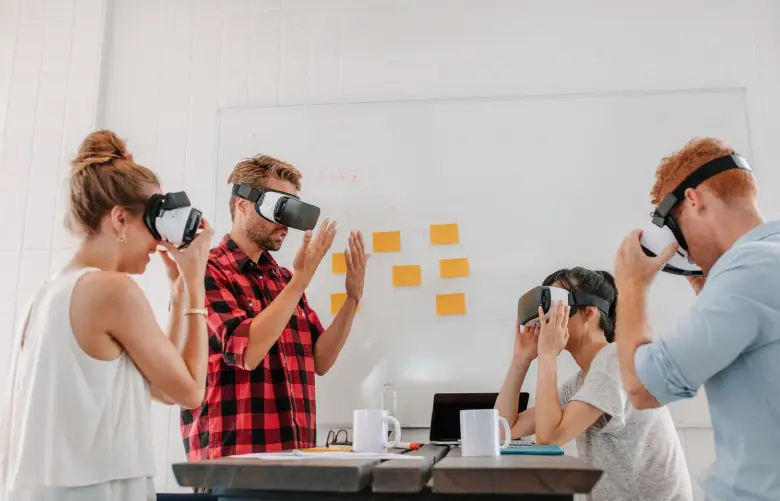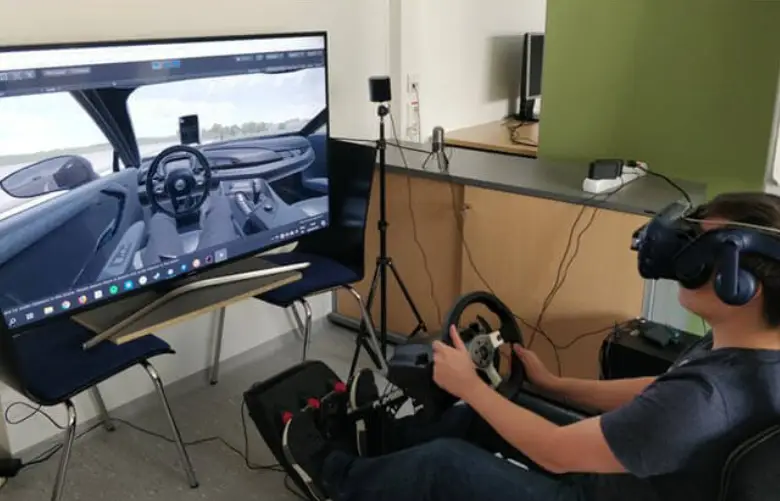With all the buzz surrounding virtual reality today, you may find yourself wondering what is virtual reality exactly? How far can it go? In this blog, we answer your questions about virtual reality and explore its applications.
Virtual Reality (VR) technology creates a simulated environment using computer-generated sensory experiences, such as visuals and sounds, to immerse users in a realistic, interactive 3D environment. It typically involves wearing a headset that covers the eyes and ears, tracking the user’s movements, and adjusting the display accordingly to give the sensation of being present within the virtual world.
Understanding Virtual Reality Technology
Virtual Reality is a technology that creates a simulated environment, usually through a headset, to immerse users in a digital world. It uses specialized hardware and software to track head and sometimes body movements.
Then, it renders corresponding visual and auditory stimuli in real time to make users feel present in the virtual environment via various virtual reality platforms.

Get curriculum highlights, career paths, industry insights and accelerate your technology journey.
Download brochure
What Are The Main Types of Virtual Reality?
Here’s a breakdown of each type of virtual reality platform:
Non-Immersive Virtual Reality Platform
A non-immersive Virtual Reality platform, often called desktop or screen-based VR, involves using a computer screen to display a virtual environment. Users interact with this environment using a keyboard, mouse, or other input devices.
Semi-Immersive Virtual Reality Platform
A Semi-immersive Virtual Reality platform enhances the user experience by incorporating more immersive technologies like larger displays or projection systems.
Fully Immersive Virtual Reality Platform
A fully immersive Virtual Reality platform aims to create a virtual experience where users are surrounded by the virtual environment, making distinguishing between the physical and virtual worlds difficult.
How Does Virtual Reality Technology Work?
Head-Mounted Display (HMD): The primary hardware component of VR is the head-mounted display, worn on the user’s head like a pair of goggles or a helmet.
Sensors and Tracking: VR systems use various sensors to make the virtual environment responsive to the user’s movements.
Content Rendering: The VR content, a simulated environment, a game, a video, or any other interactive experience, is created using computer graphics.
Motion Control: Many VR systems come with handheld controllers that allow users to interact with the virtual environment.

What is Virtual Reality Used For?
Training and Simulation: VR is extensively used for training simulations in aviation, military, healthcare, and industrial sectors. Pilots, surgeons, and soldiers can all benefit from realistic training without the associated risks.
Education and Learning: VR can enhance traditional education methods by creating immersive learning experiences. Students can explore historical sites, travel to outer space, or visualize complex scientific concepts in three dimensions. This makes learning more engaging and effective.
Architecture and Design: Architects and designers use VR to create and showcase their designs in a virtual space. Clients and stakeholders can walk through virtual buildings, helping them better understand the design before it’s built.
Healthcare and Therapy: VR is utilized in pain management, exposure therapy for phobias, and rehabilitation exercises. It provides a controlled environment for patients to confront their fears or practice physical therapy exercises.
Immersive Experiences: Virtual Reality offers a level of immersion that traditional media cannot match. It creates a sense of presence where users feel physically present in a digital environment.
Training and Education: Virtual Reality provides a safe and controlled environment for training scenarios. It’s used in aviation, medicine, and military training to simulate real-life situations without the associated risks.
Virtual Prototyping: Industries like architecture, automotive design, and manufacturing use VR for virtual prototyping.
To gain a certification in Extended Reality (VR+AR) and leverage your futuristic and immersive knowledge professionally, click here!
What Are Some of The Benefits of VR?
Immersive Experiences: This immersive nature enhances engagement and emotional connections, making experiences more vivid and memorable.
Training and Education: VR is extensively used for training in fields like medicine, aviation, military, and more. It allows trainees to practice in realistic simulations without real-world risks, facilitating skill development and knowledge retention.
Medical Applications: VR is employed for pain management, physical therapy, and exposure therapy for treating phobias and anxiety disorders. It can also aid in motor skills rehabilitation and cognitive therapy.
Architectural Visualization: Architects and designers use VR to create virtual walkthroughs of buildings and spaces before construction.
What Are Some Disadvantages of VR?
Expense: High-quality VR setups can be expensive, requiring the VR headset itself and a powerful computer or gaming console to run the VR experiences smoothly.
Limited Content: While the library of VR content has been growing steadily, it’s still more limited compared to traditional gaming and entertainment options.
Technical Challenges: Setting up VR systems can be complex and require technical know-how. Calibrating sensors, managing cables, and ensuring optimal performance can be daunting for less tech-savvy users.
Physical Space Requirements: Many VR experiences require adequate physical space for movement, which may not be available to everyone.
Challenges of Virtual Reality
Hardware Limitations: VR hardware, including headsets and controllers, can be bulky expensive, and require high-end computing power to deliver smooth and realistic experiences. Advancements in hardware miniaturization, affordability, and performance are necessary to make VR more accessible.
Content Development: Creating high-quality VR content requires different skills and tools than traditional media. Developing engaging and immersive experiences demands 3D modeling, spatial audio, and interactive design expertise.
Health and Safety Concerns: Prolonged use of VR can have potential health impacts, including eye strain, fatigue, and posture-related issues.
Content Quality and Variety: While VR content has been growing, there’s still a need for a diverse range of high-quality experiences that cater to various interests and demographics.
What is Virtual Reality vs. Augmented Reality?
While both virtual reality and augmented reality are immersive technologies that alter our perception of the physical world, they differ significantly in how they integrate digital content with the real world and the primary use cases they address. Here are some of the differences between virtual reality and augmented reality.
| Aspect |
Virtual Reality (VR) |
Augmented Reality (AR) |
| Definition |
Immersive digital experience in a simulated environment isolates the user from the physical world. |
Overlaying digital elements onto the real-world environment, enhancing it with additional information. |
| User Perspective |
The user is fully immersed and isolated from the real world. |
The user remains aware of the real world while interacting with digital elements. |
| Applications |
Gaming, simulations, training, virtual tourism. |
Education, navigation, real-time data visualization, gaming. |
| Examples |
Oculus Rift, HTC Vive, PlayStation VR. |
Pokémon GO, Snapchat filters, Microsoft HoloLens. |
| Challenges |
Motion sickness, high hardware costs. |
Real-time tracking seamless blending of digital content with the real world. |
| Dependency on Devices |
Typically requires dedicated VR headsets and powerful computers. |
It can be experienced on various devices, from smartphones to specialized glasses. |
| Isolation Level |
High isolation from the physical world. |
Low to moderate isolation, maintaining a connection to the real world. |
| Tech Complexity |
Complex system with advanced tracking and rendering technologies. |
Relies on computer vision and object recognition, with less intense rendering demands. |

Virtual Reality: A New Frontier in Technology
Therapeutic Applications: VR is being explored for therapeutic purposes as well. It treats phobias and anxiety disorders by gradually exposing individuals to their fears in a controlled environment.
Architectural Visualization: VR enables architects and designers to create immersive walkthroughs of their designs before they are built. This helps identify design flaws and make improvements in a virtual setting, saving time and resources.
Social Interaction: Social VR platforms allow people to meet and interact in virtual spaces as avatars. This could affect long-distance relationships, remote work, and virtual conferences.
Virtual Reality in Entertainment and Beyond
- Entertainment:
- Gaming
- Movies and Cinematic Experiences
- Theme Parks and Attractions
- Training and Education:
- Simulation-Based Training
- Medical Training
- Architecture and Design:
- Real Estate:
Conclusion
One can create the Virtual Worlds of Tomorrow With the Game Design Program, with virtual reality equipment. Virtual Reality has emerged as a transformative technology with wide-ranging applications. Entertainment, training, education, design, and beyond. Its immersive capabilities have reshaped how we experience content, learn, and interact with environments.
FAQs
Virtual Reality (VR) technology finds applications in a wide range of fields, including:
- Gaming
- Training and Simulations
- Education
- Architecture and Design
- Healthcare
VR brings several benefits to industries:
- Enhanced Learning
- Cost-Effective Training
- Design and Visualization
- Therapeutic Applications
- Data Visualization
Non-Immersive VR: Unlike desktop VR, this involves viewing virtual environments on a computer screen. Interaction is limited, and the sense of immersion is minimal.
Semi-Immersive VR: This type offers a more engaging experience with larger screens, better graphics, and some physical interaction, but it doesn't fully envelop the user.
Fully Immersive VR: Users wear headsets that cover their field of vision and often include hand-tracking controllers.
Virtual Reality holds significance due to its transformative potential across various sectors:
- Education Evolution
- Innovative Training
- Therapeutic Advancements
- Remote Experiences
- Data Interpretation
- Design and Prototyping
Virtual Reality is driving technological change by:
- Changing Interaction Paradigms
- Creating New Industries
- Shaping Communication
- Challenging Realities
- Driving Innovation










